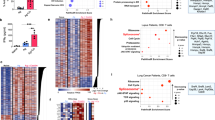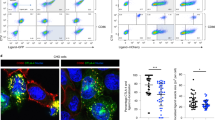Abstract
CD94/NKG2A is an inhibitory receptor expressed by natural killer (NK) cells and a subset of CD8+ T cells. Ligation of CD94/NKG2A by its ligand HLA-E results in tyrosine phosphorylation of the NKG2A immunoreceptor tyrosine-based inhibitory motifs, and recruitment and activation of the SH2 domain-bearing tyrosine phosphatase-1, which in turn suppresses activation signals. The nkg2a gene encodes two isoforms, NKG2A and NKG2B, with the latter lacking the stem region. We identified three new alternative transcripts of the cd94 gene in addition to the originally described canonical CD94Full. One of the transcripts, termed CD94-T4, lacks the portion that encodes the stem region. CD94-T4 associates with both NKG2A and NKG2B, but preferentially associates with the latter. This is probably due to the absence of a stem region in both CD94-T4 and NKG2B. CD94-T4/NKG2B is capable of binding HLA-E and, when expressed in E6-1 Jurkat T cells, inhibits TCR mediated signals, demonstrating that this heterodimer is functional. Coevolution of stemless isoforms of CD94 and NKG2A that preferentially pair with each other to produce a functional heterodimer indicates that this may be more than a serendipitous event. CD94-T4/NKG2B may contribute to the plasticity of the NK immunological synapse by insuring an adequate inhibitory signal.
This is a preview of subscription content, access via your institution
Access options
Subscribe to this journal
Receive 6 digital issues and online access to articles
$119.00 per year
only $19.83 per issue
Buy this article
- Purchase on Springer Link
- Instant access to full article PDF
Prices may be subject to local taxes which are calculated during checkout





Similar content being viewed by others
Accession codes
Accessions
GenBank/EMBL/DDBJ
References
Biron CA, Brossay L . NK cells and NKT cells in innate defense against viral infections. Curr Opin Immunol 2001; 13: 458–464.
Soloski MJ . Recognition of tumor cells by the innate immune system. Curr Opin Immunol 2001; 13: 154–162.
Lanier LL . NK cell recognition. Annu Rev Immunol 2005; 23: 225–274.
Colucci F, Di Santo JP, Leibson PJ . Natural killer cell activation in mice and men: different triggers for similar weapons? Nat Immunol 2002; 3: 807–813.
Moretta A, Bottino C, Vitale M, Pende D, Cantoni C, Mingari MC et al. Activating receptors and coreceptors involved in human natural killer cell-mediated cytolysis. Annu Rev Immunol 2001; 19: 197–223.
Borrego F, Kabat J, Kim DK, Lieto L, Maasho K, Pena J et al. Structure and function of major histocompatibility complex (MHC) class I specific receptors expressed on human natural killer (NK) cells. Mol Immunol 2002; 38: 637–660.
Kumar V, McNerney ME . A new self: MHC-class-I-independent natural-killer-cell self-tolerance. Nat Rev Immunol 2005; 5: 363–374.
Lanier LL . Face off – the interplay between activating and inhibitory immune receptors. Curr Opin Immunol 2001; 13: 326–331.
Kabat J, Borrego F, Brooks A, Coligan JE . Role that each NKG2A immunoreceptor tyrosine-based inhibitory motif plays in mediating the human CD94/NKG2A inhibitory signal. J Immunol 2002; 169: 1948–1958.
Long EO . Regulation of immune responses through inhibitory receptors. Annu Rev Immunol 1999; 17: 875–904.
Brooks AG, Posch PE, Scorzelli CJ, Borrego F, Coligan JE . NKG2A complexed with CD94 defines a novel inhibitory natural killer cell receptor. J Exp Med 1997; 185: 795–800.
Borrego F, Ulbrecht M, Weiss EH, Coligan JE, Brooks AG . Recognition of human histocompatibility leukocyte antigen (HLA)-E complexed with HLA class I signal sequence-derived peptides by CD94/NKG2 confers protection from natural killer cell-mediated lysis. J Exp Med 1998; 187: 813–818.
Braud VM, Allan DS, O’Callaghan CA, Soderstrom K, D’Andrea A, Ogg GS et al. HLA-E binds to natural killer cell receptors CD94/NKG2A, B and C. Nature 1998; 391: 795–799.
Brooks AG, Borrego F, Posch PE, Patamawenu A, Scorzelli CJ, Ulbrecht M et al. Specific recognition of HLA-E, but not classical, HLA class I molecules by soluble CD94/NKG2A and NK cells. J Immunol 1999; 162: 305–313.
Borrego F, Kabat J, Sanni TB, Coligan JE . NK cell CD94/NKG2A inhibitory receptors are internalized and recycle independently of inhibitory signaling processes. J Immunol 2002; 169: 6102–6111.
Borrego F, Masilamani M, Kabat J, Sanni TB, Coligan JE . The cell biology of the human natural killer cell CD94/NKG2A inhibitory receptor. Mol Immunol 2005; 42: 485–488.
Lieto LD, Borrego F, You CH, Coligan JE . Human CD94 gene expression: dual promoters differing in responsiveness to IL-2 or IL-15. J Immunol 2003; 171: 5277–5286.
Marusina AI, Kim DK, Lieto LD, Borrego F, Coligan JE . GATA-3 is an important transcription factor for regulating human NKG2A gene expression. J Immunol 2005; 174: 2152–2159.
Bellon T, Heredia AB, Llano M, Minguela A, Rodriguez A, Lopez-Botet M et al. Triggering of effector functions on a CD8+ T cell clone upon the aggregation of an activatory CD94/kp39 heterodimer. J Immunol 1999; 162: 3996–4002.
Plougastel B, Jones T, Trowsdale J . Genomic structure, chromosome location, and alternative splicing of the human NKG2A gene. Immunogenetics 1996; 44: 286–291.
Furukawa H, Yabe T, Watanabe K, Miyamoto R, Akaza T, Tadokoro K et al. An alternatively spliced form of the human CD94 gene. Immunogenetics 1998; 48: 87–88.
Chang C, Rodriguez A, Carretero M, Lopez-Botet M, Phillips JH, Lanier LL . Molecular characterization of human CD94: a type II membrane glycoprotein related to the C-type lectin superfamily. Eur J Immunol 1995; 25: 2433–2437.
Boyington JC, Raiz AN, Brooks AG, Patamawenu A, Sun PD . Reconstitution of bacterial expressed human CD94: the importance of the stem region for dimer formation. Protein Exp Purif 2000; 18: 235–241.
Boyington JC, Riaz AN, Patamawenu A, Coligan JE, Brooks AG, Sun PD . Structure of CD94 reveals a novel C-type lectin fold: implications for the NK cell-associated CD94/NKG2 receptors. Immunity 1999; 10: 75–82.
Phillips JH, Chang C, Mattson J, Gumperz JE, Parham P, Lanier LL . CD94 and a novel associated protein (94AP) form a NK cell receptor involved in the recognition of HLA-A, HLA-B, and HLA-C allotypes. Immunity 1996; 5: 163–172.
McCann FE, Suhling K, Carlin LM, Eleme K, Taner SB, Yanagi K et al. Imaging immune surveillance by T cells and NK cells. Immunol Rev 2002; 189: 179–192.
Vyas YM, Maniar H, Dupont B . Visualization of signaling pathways and cortical cytoskeleton in cytolytic and noncytolytic natural killer cell immune synapses. Immunol Rev 2002; 189: 161–178.
Vyas YM, Mehta KM, Morgan M, Maniar H, Butros L, Jung S et al. Spatial organization of signal transduction molecules in the NK cell immune synapses during MHC class I-regulated noncytolytic and cytolytic interactions. J Immunol 2001; 167: 4358–4367.
Fassett MS, Davis DM, Valter MM, Cohen GB, Strominger JL . Signaling at the inhibitory natural killer cell immune synapse regulates lipid raft polarization but not class I MHC clustering. Proc Natl Acad Sci USA 2001; 98: 14547–14552.
Sanni TB, Masilamani M, Kabat J, Coligan JE, Borrego F . Exclusion of lipid rafts and decreased mobility of CD94/NKG2A receptors at the inhibitory NK cell synapse. Mol Biol Cell 2004; 15: 3210–3223.
McCann FE, Vanherberghen B, Eleme K, Carlin LM, Newsam RJ, Goulding D et al. The size of the synaptic cleft and distinct distributions of filamentous actin, ezrin, CD43, and CD45 at activating and inhibitory human NK cell immune synapses. J Immunol 2003; 170: 2862–2870.
Burroughs NJ, Wulfing C . Differential segregation in a cell-cell contact interface: the dynamics of the immunological synapse. Biophys J 2002; 83: 1784–1796.
Davis DM, Chiu I, Fassett M, Cohen GB, Mandelboim O, Strominger JL . The human natural killer cell immune synapse. Proc Natl Acad Sci USA 1999; 96: 15062–15067.
Choudhuri K, Wiseman D, Brown MH, Gould K, van der Merwe PA . T-cell receptor triggering is critically dependent on the dimensions of its peptide-MHC ligand. Nature 2005; 436: 578–582.
Davis SJ, Ikemizu S, Evans EJ, Fugger L, Bakker TR, van der Merwe PA . The nature of molecular recognition by T cells. Nat Immunol 2003; 4: 217–224.
Vales-Gomez M, Reyburn HT, Erskine RA, Lopez-Botet M, Strominger JL . Kinetics and peptide dependency of the binding of the inhibitory NK receptor CD94/NKG2-A and the activating receptor CD94/NKG2-C to HLA-E. Embo J 1999; 18: 4250–4260.
Acknowledgements
We appreciate the advice and comments of Drs Steven Burgess, Madhan Masilamani, Sriram Narayanan and Xiaobin Tang. We also would like to thank Robert Valas for the NK cell isolation. This work was supported by the NIAID, National Institutes of Health Intramural Research Program.
Author information
Authors and Affiliations
Corresponding author
Rights and permissions
About this article
Cite this article
Lieto, L., Maasho, K., West, D. et al. The human CD94 gene encodes multiple, expressible transcripts including a new partner of NKG2A/B. Genes Immun 7, 36–43 (2006). https://doi.org/10.1038/sj.gene.6364268
Received:
Revised:
Accepted:
Published:
Issue Date:
DOI: https://doi.org/10.1038/sj.gene.6364268
Keywords
This article is cited by
-
Engineered off-the-shelf therapeutic T cells resist host immune rejection
Nature Biotechnology (2021)
-
KLRD1-expressing natural killer cells predict influenza susceptibility
Genome Medicine (2018)
-
High diversification of CD94 by alternative splicing in New World primates
Immunogenetics (2013)
-
Clinical Significance of the HLA-E and CD94/NKG2 Interaction
Archivum Immunologiae et Therapiae Experimentalis (2011)
-
Variation in the ligand binding domains of the CD94/NKG2 family of receptors in the squirrel monkey
Immunogenetics (2007)



